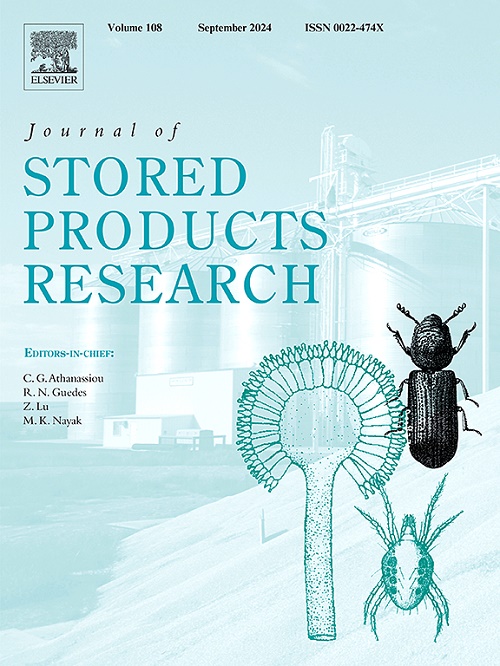Numerical simulation and energy consumption analysis of ventilation patterns in grain silo
IF 2.7
2区 农林科学
Q1 ENTOMOLOGY
引用次数: 0
Abstract
Mechanical ventilation is an effective method to ensure the security of grain storage, which directly impacts the storage duration and storage quality. In this work, considering the coupling effect of grain physical parameters and gas-solid phase interaction on ventilation, the porous media, non-thermal equilibrium and turbulence models were employed to investigate the variation of velocity field and temperature field under four ventilation patterns: vertical ventilation duct (VD), transverse ventilation duct (HD), combined roof inhalation duct (CRD), and combined bottom inhalation duct (CBD). The relative standard deviation (RSD) and unit energy consumption were used to evaluate the performance of different ventilation patterns quantitatively. The results show a relative deviation of 5.12 % between simulation and experiments. Compared with VD and HD, CRD and CBD exhibit higher velocity values and gradient in the center of grain silo. The physical parameters of grain have obvious impacts on velocity field, and paddy has the highest velocity values due to its higher porosity. CRD has a significant advantage in cooling speed and effect, with the grain surface temperature at 12 m and 25 m lower than other patterns by 1.2 °C and 1.8 °C, respectively. The large porosity of paddy can advance cooling time by up to 5–10 h, while the lower specific heat capacity and higher thermal conductivity of peanut result in cooling temperatures 1.5 °C–2.4 °C lower than other grain. The temperature RSD of VD is lower than other ventilation patterns, and the unit energy consumption of CRD and CBD is better.
粮仓通风模式的数值模拟和能耗分析
机械通风是保证粮食储藏安全的有效方法,直接影响储藏时间和储藏质量。本研究考虑了粮食物理参数和气固相相互作用对通风的耦合效应,采用多孔介质模型、非热平衡模型和湍流模型研究了垂直通风管道(VD)、横向通风管道(HD)、组合式顶部吸入管道(CRD)和组合式底部吸入管道(CBD)四种通风模式下的速度场和温度场的变化。采用相对标准偏差(RSD)和单位能耗来定量评估不同通风模式的性能。结果显示,模拟与实验之间的相对偏差为 5.12%。与 VD 和 HD 相比,CRD 和 CBD 在粮仓中心表现出更高的速度值和梯度。谷物的物理参数对速度场有明显的影响,稻谷由于孔隙率较高,速度值最高。CRD 在冷却速度和效果方面具有明显优势,12 米和 25 米处的谷物表面温度分别比其他模式低 1.2 ℃ 和 1.8 ℃。稻谷的孔隙率大,可将冷却时间提前 5-10 小时,而花生的比热容较低,导热系数较高,因此冷却温度比其他谷物低 1.5 ℃-2.4 ℃。VD 的温度 RSD 低于其他通风模式,CRD 和 CBD 的单位能耗较好。
本文章由计算机程序翻译,如有差异,请以英文原文为准。
求助全文
约1分钟内获得全文
求助全文
来源期刊
CiteScore
5.70
自引率
18.50%
发文量
112
审稿时长
45 days
期刊介绍:
The Journal of Stored Products Research provides an international medium for the publication of both reviews and original results from laboratory and field studies on the preservation and safety of stored products, notably food stocks, covering storage-related problems from the producer through the supply chain to the consumer. Stored products are characterised by having relatively low moisture content and include raw and semi-processed foods, animal feedstuffs, and a range of other durable items, including materials such as clothing or museum artefacts.

 求助内容:
求助内容: 应助结果提醒方式:
应助结果提醒方式:


